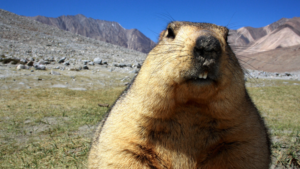
Himalayan Marmot
A social rodent adapted to cold, high-altitude environments
Conservation Status | Low Risk
The Himalayan Marmot (Marmota himalayana) is a large, burrowing rodent found in the high-altitude grasslands of the Himalayas, including northern Pakistan. Known for their distinct calls and highly social behavior, marmots play a vital role in their ecosystem by aerating soil and providing prey for larger predators.
Habitat & Lifestyle
Himalayan Marmots live in alpine meadows and rocky slopes, typically at elevations between 3,500 and 5,200 meters. They are social animals that live in colonies and build extensive burrow systems. Marmots are diurnal, spending their mornings and afternoons foraging for grasses, roots, and herbs. During the harsh winter months, they hibernate in their burrows, living off body fat accumulated in the warmer months.
Area Found
In Pakistan, Himalayan Marmots are found in the northern regions, particularly in Gilgit-Baltistan and parts of the Deosai National Park, where the high-altitude environment and open grasslands provide ideal conditions for their colonies.
Quick Facts
- Length: 45-65 cm.
- Weight: 4-9 kg.
- Stocky build with a thick, brownish-yellow coat and bushy tail, suited for insulation against cold temperatures.
- Primary predators include Snow Leopards, Golden Eagles, and foxes.
- Himalayan Marmots have a distinctive warning call, a loud whistle they use to alert colony members of approaching predators.




Did you spot a mistake or have more to add? Let us know!
Your feedback helps Haewan keep information accurate and up-to-date.
